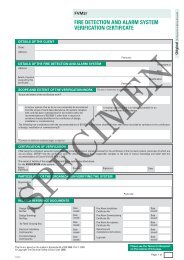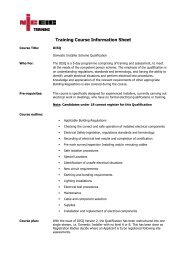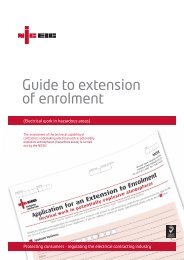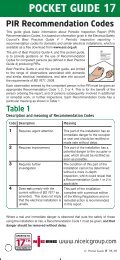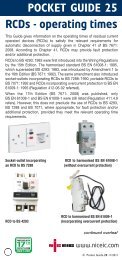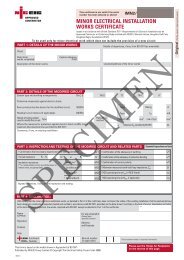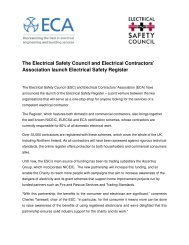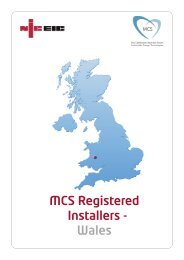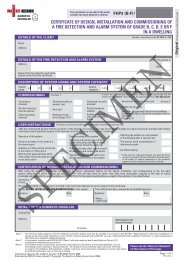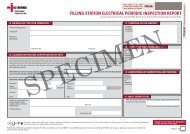Health & Safety Policy - NICEIC
Health & Safety Policy - NICEIC
Health & Safety Policy - NICEIC
Create successful ePaper yourself
Turn your PDF publications into a flip-book with our unique Google optimized e-Paper software.
2In t ro d u c t i o nWhat is a health and safety policy statement?Your health and safety policy statement setsout how you manage health and safety in youro rganisation. It is a unique document that showswho does what; and when and how they do it.This is an example of a policy statement thatyou can use, fill in and keep in your workplace.H o w e v e r, you do not have to use this documentor format. You are free to re c o rd and store thei n f o rmation in any form you choose. This form a tgives you an idea of the kind of information youneed to re c o rd .Why do I need a health and safety policy statement?The health and safety policy statement is yourstarting point to managing health and safety inthe workplace. By law, (<strong>Health</strong> and <strong>Safety</strong> atWork etc Act 1974 section 2(3)) if you employfive or more people you must have a writtenhealth and safety policy. This contains yourstatement of general policy on health and safetyat work and the organisation and arrangementsfor putting that policy into practice.Writing a health and safety policy statement ism o re than just a legal re q u i rement – it is yourcommitment to planning and managing healthand safety. It is the key to achieving acceptables t a n d a rds, reducing accidents and cases of workrelatedill health and it shows your employeesthat you care for their health and safety.Who should do what?With very few exceptions, the responsibility forhealth and safety rests on you as an employer.However, many day-to-day tasks may bedelegated. Your statement should show clearlyhow these tasks are allocated, but remember,you will still have ultimate responsibility.You should consult your employees (throughsafety representatives, if you have any) aboutthe policy statement. Everyone should be ableto see from the policy statement exactly who isresponsible for different things, such as advice,reporting an accident, and first aid.When and how should they do it?Your policy statement should describe yourarrangements, ie the systems and proceduresyou have in place for ensuring employees’health and safety.You may wish to refer to other documents,eg works’ rules, safety checklists, trainingprogrammes, emergency instructions, etc.All employees may not need to see all theother documents, but they must see the policystatement itself.How often do I need to revise the policy statement?It should be reviewed and possibly revised in thelight of experience, or because of operational oro rganisational changes. It is useful to review thepolicy regularly (eg annually).Do I have to do anything else?Yes, you have other legal duties under otherlegislation. In particular, under the Managementof <strong>Health</strong> and <strong>Safety</strong> at Work Regulations 1999,you have to assess the risks arising from yourwork activities and record the significant findings(you can cro s s - refer to page 5 of this document).You also have to record your arrangements forhealth and safety (you can use this document todo that). Depending on your type of work, theremay be other specific legislation that will apply.REMEMBER: What you write in the policyhas to be put into practice. The true testof a health and safety policy is the actualconditions in the workplace, not how wellthe statement is written.How to use this guidanceThis guidance is split into three parts. It containsa statement of general policy based on your legalduties under the <strong>Health</strong> and <strong>Safety</strong> at Work etcAct 1974. Then you can re c o rd your org a n i s a t i o n a lresponsibilities and your arrangements to ensurethe health and safety of your employees. Notesa re included alongside each section to help you.Some useful publications are listed in the notesand at the end of this guidance.



